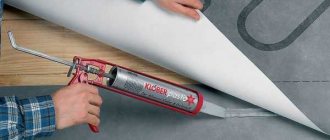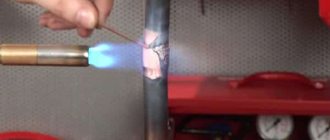During the operation of systems containing pipelines, leaks often occur. Such malfunctions can occur as a result of careless handling, improper installation, or simply due to wear and tear of the material. Moreover, a leak can occur in pipes made of both metal and plastic-containing substances (plastic, metal-plastic, polypropylene, etc.)
The following troubleshooting methods are available:
- Mechanical
- Chemical
- Combined.
The first type is associated with the use of improvised means. Self-tapping screws, harnesses, clamps and more can act in this capacity.
With the chemical method, the malfunction is eliminated using adhesive and astringent chemicals, such as silicone or other sealant.
The latter method involves the use of mechanical means and chemicals.
Regardless of which method will be used, it is necessary to decide “whether it is necessary to shut off the entire water supply system, only a separate part of it, or whether shutting off is not required at all.”
In case of small diameter holes (up to 2-3 mm), shutting down the system is not necessary. If holes of a larger diameter appear, in order to avoid emergency situations, it is better to shut off the network above the leakage point (along the direction of movement of the liquid in the pipe).
How to repair a leak in a pipe: mechanical methods
There are various methods using available materials to close the damage in the pipe.
Seal a leak in a metal pipe using a self-tapping screw.
In the event that on a metal pipe with a wall thickness of more than 3 mm. a small “drip” type hole with a diameter of up to 3 mm was formed. You can use a regular self-tapping screw with a rubber washer:
- The surface around the damage should be cleaned of rust deposits using a file.
- Then a self-tapping screw with a rubber washer is screwed into the hole, ensuring that the protruding part of the self-tapping screw inside the pipe is minimal. To carry out the work, it is better to use a screwdriver or electric drill.
In order to avoid damage to the tool, you should use a screwdriver with a built-in battery, wrapped in polyethylene.
Seal a leak with a diameter of more than 3 mm in a metal pipe.
If such a problem occurs, the danger of an emergency situation increases and most likely a screwed-in screw will help, but not for a long time, but you can try screwing several screws into one hole. In this situation, it is better to use a bolt, having first made a thread for it in the resulting hole. As in the previous case, there should be a rubberized washer on the bolt, and its protrusion above the inner surface of the pipe is minimal.
First actions
What to do if a hot water pipe, a cold water pipe or a heating system that is under pressure is leaking? First of all you need to:
- turn off the liquid supply to the pipes if the leak is located after installing an individual shut-off valve, or find any rag, wrap it around the leak site, leaving one end long enough, and place the long end in any collection container (basin, bucket, tank, etc. ). This will help avoid flooding of premises;
If the leak is small, then you can limit yourself to installing a collection tank.
Collecting water to avoid flooding
- report the accident to the management company or emergency service. Telephone numbers of all service organizations, as a rule, are indicated on receipts for payment of utility services.
How to eliminate a leak in a pipe: malfunctions of systems and products made of various materials
Depending on the location of the damage and the material from which the system or its individual parts are made, there are also the following ways to eliminate them:
Seal a leak in the heating battery (radiator)
- The main battery malfunctions are divided into the following types: formation of cracks in the case. Such damage can be repaired using cold welding (an adhesive consisting of two components prepared on the basis of epoxy resin). This glue is highly resistant to high temperatures and humidity. Before starting to apply it, you must turn off the system from the water supply and clean the surface using sandpaper or a file.
- the malfunction is caused by poor sealing of the seams between the individual sections. In most cases, to solve the problem, you will have to replace the entire radiator, or a separate section of it (for multi-section collapsible batteries). But to urgently repair the damage, you can use the following method. Available tools will require alabaster, cement, water, medical bandage or gauze. Alabaster, cement and water are mixed in any container until thick. Then strips of bandage or gauze are dipped into the resulting mixture and applied to the damage in several layers (from 2). The radiator can be used only after the pad has completely dried.
- The leak occurs at the junction of the radiator and the pipeline. This problem is most often caused by poor installation of the product. During battery operation, the vulnerable spot is subjected to heavy load and, as a result, a leak occurs. Such a malfunction can be eliminated using a rubber gasket and a clamp (or regular wire). The gasket can be made from a piece of a car inner tube. The overlay is cut out with a “spare” and wrapped around the damaged area. Then it is tightened with a clamp or wire (using pliers).
How to fix a leak in a plastic pipe
- To eliminate leaks on polymer pipes, there are methods similar to methods for eliminating leaks on products made from other materials: a common way to eliminate damage on a straight section of a pipe is to apply a rubber band or a similar “tightening” material. Such a gasket is attached to the pipe using metal clamps (which may already contain a rubber gasket), plastic ties or wire.
- Very small cracks and leaks in a straight section can be solved by wrapping regular electrical tape in 4-5 layers. It is important to take into account that each subsequent turn should overlap the previous one by 2-3 mm.
- Also, a very small leak (droplet type) can be solved by applying oil paint to a previously cleaned and degreased surface. It is worth remembering that this method will most likely eliminate the problem for a short period of time, and in the future it will make itself felt.
- Various chemical compounds can help eliminate leaks on straight sections of plastic pipes, bends and joints. These can be various sealants, cold welding (epoxy-based glue), silicone-based adhesives. The main rule that must be followed is that the composition must be applied to a completely dry, cleaned (using a file or sandpaper) and degreased (acetone and other solvents) surface. When using chemically active substances, you should wear gloves and carefully read the instructions for their use.
Fistula sealing in plastic pipelines
Plastic pipe materials have recently been used very often. They quickly replaced conventional steel products, thanks to a wide range of positive characteristics. These materials are not only easy to install, but also easy to repair when fistulas appear.
Using connecting elements, it is installed in place of the area that has become unusable. If you are not sure that all actions were performed correctly, you can seek advice from a professional technician.
After inspecting the structure, he will give an accurate answer as to whether it is suitable for use, or will advise a complete replacement of the damaged pipe.
To ensure that water pressure (find out the optimal values for the plumbing system) does not interfere with repairs, it is necessary to turn off the main valve. It is usually installed in the toilet.
Video: eliminating water leaks in accessible ways
The main causes of leaks in pipelines
There is no point in filling holes in old pipes; they need to be replaced completely.
A fistula is pitting corrosion in one of the sections of a metal pipeline. More often such phenomena are characteristic of cast iron and steel. Unfortunately, time takes its toll, and rust simply eats away the metal in places. As a result, water leaks through the holes formed and floods form.
The first signs of a future fistula are corrosive growths on the surface of the pipe or paint swollen in these places. The main causes of holes are:
- active influence of rust on metal from the inside or outside;
- broken highway installation technology - joints and welds are especially weak in this regard;
- frequent mechanical impact on the line - strong shocks, accidental frequent touches over time lead to depressurization of the pipes.
- sudden, frequent abnormal pressure drops in the system.
If you find a build-up of rye on a pipe, do not rush to tear it off. It is unknown how big the fistula was hidden underneath.
Factors characterizing system depressurization
The heating system consists of the following main elements:
- heating boiler;
- pipeline;
- radiators;
- control and measuring and shut-off valves.
All of the listed elements are mounted in a heating circuit, the tightness of which depends on the integrity of the constituent elements and their connections.
The choice of method to restore the integrity of the heating system depends on the following factors:
- accessibility of the damage site;
- leak status (fistula, loss of tightness of a threaded connection, etc.);
- material of manufacture of the damaged element;
- availability of the ability to disable the system.
Based on the totality of the above circumstances, a method is selected to most effectively seal the leak in the heating pipe in the current situation.
Best answers
Yaoza:
Here! There can be problems just because of the sewer pipe! The neighbors downstairs are so sick of me that I keep filling them up and filling them up. First I changed the water supply pipes - they complained. Then it was time for the sewer system - but they didn’t want to change their tee (the one between the floors, into which my horizontal pipes and the riser itself go), I just changed the pipes, inserted a new one into the old sewer tee. And it turned out that it was precisely this that was leaking - there was a crack between the floors. That's where it leaked. Then they had to change this tee anyway. Of course, the water in the sewer does not constantly flow, but when the upper floors are lowered, the water flows down + the circular centrifugal movement of water inside the pipe - that’s what happens. that it gets into the crack of the pipe.
Galina Nikitina:
After our renovation, water also flowed down from us, and when our neighbors from above drained the bathtub. It turned out that some kind of thing like a tray was not installed in our toilet... They did it - and there are no problems.
Winds:
Canal water riser (for example, the junction of the outlet channel to the toilet may be poorly sealed, and with high pressure of water from the bathtub or when flushing the tank) it may end up on the neighbors’ ceiling. You must clearly describe (or take a photo) the projection of the leak..
when chipped in channel. riser - water can gush out of the fistula onto the wall and flow down.
Romance:
Our neighbors also accused us more than once of drowning them, they even came from the zhek, I’m not saying we’re dry here, but they mean it’s dry, but damn.. . how dry it is if the neighbors are still dripping. I personally climbed under the bathtub and checked in the toilet - it was dry! I sent it to the neighbors above, but no one listened to me. They drowned us more than once and the water has already done its job, finding new passages
647 acc:
The problem could be in the sewer pipe! ! !I live in a five-story panel Khrushchev building, there are 20 apartments in the entrance, our riser is adjacent to 10 apartments. In apartment 62 on the first floor there was dripping from the ceiling, we live in apartment 67 on the second floor. The cast iron sewer tee between the floors was leaking. The mechanic from the housing department replaced him in three apartments at once: in ours, 66 and 62. After his replacement, everything became normal. And before that, the neighbors from apartment 62 also came to us saying that we were drowning them, but ours was dry.
Are her boners dry? The fact is that water can flow from the floors in its ceiling, neatly flowing down the risers. Have you checked this? The plumbers from your housing department are simply too lazy to look, there are never consequences without a reason. Well, or a cold riser leaking in the ceiling... That the leak is in the ceiling is already a 100% option.
Raffi Baghdasaryan:
Cold water supply, hot water supply and sewerage pipes pass through the floors in floor slabs, in hot water supply and hot water supply sleeves, this is according to SNiP. Due to the negligence of builders, sometimes they pass without sleeves and when they come into contact with concrete, the pipes quickly rot. If the floor slab is hollow, then water can pass through the hollow and seep further from the riser. As for sewer pipes, there may be a crack in the passage through the ceilings, which is also the cause of flooding.
Getting rid of leaks with a bandage
A plumbing bandage is a piece of pipe, cut along the longitudinal axis and equipped with eyes for a screw tie. Bandages are made of durable metal - cast iron or aluminum, steel. Polymer bandages can be used to repair plastic pipes.
In welded structures, sometimes a seam running along the entire pipe begins to leak. In the initial stage of a leak, individual holes are almost indistinguishable to the naked eye. In this case, applying one or more bandages helps. However, a defective welded pipe should be replaced as soon as possible.
The disadvantages of the bandage are its high cost and low efficiency when sealing fistulas on an uneven surface. A hole that has rusted in the immediate vicinity of a poorly executed weld may not be closed tightly enough with a bandage. In this case, the leakage will resume after some time.
What difficulties may arise
During repair welding of water pipes using electric welding, the quality of the seam from contact with water will be low. This repair of defects is a temporary measure. It is not provided for by GOST. When water pressure increases and the system is pressurized, the seam formed during welding can crack. Not all welders undertake this type of work. Surfacing of metal in the damaged zone often leads to multiple fistulas around the welding zone, because during welding the oxidation process is activated by contact with water. Instead of one fistula, many are formed.
Welding a pipeline containing water is a technologically complex job for a number of reasons:
- Due to the steam generated from the water during welding, you have to periodically wipe the mask; the work area is difficult to see.
- Water constantly cools the welding working area and prevents the metal from penetrating to great depths. Setting occurs immediately and crystallization begins.
- When pipelines located under the ceiling leak, work clothes get wet from the water. This is fraught with breakdown of current. The hand twitches and the electrode gets stuck.











